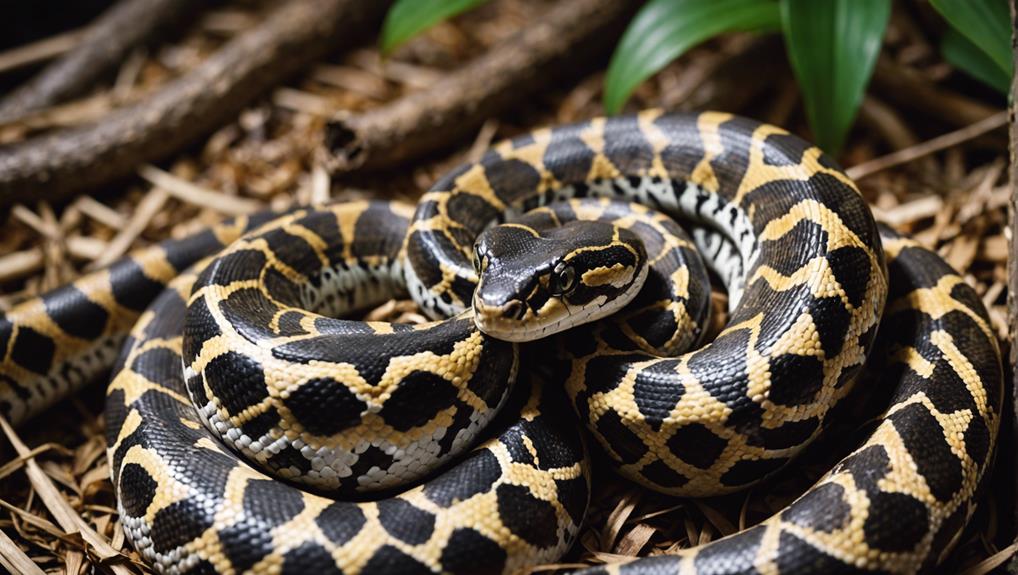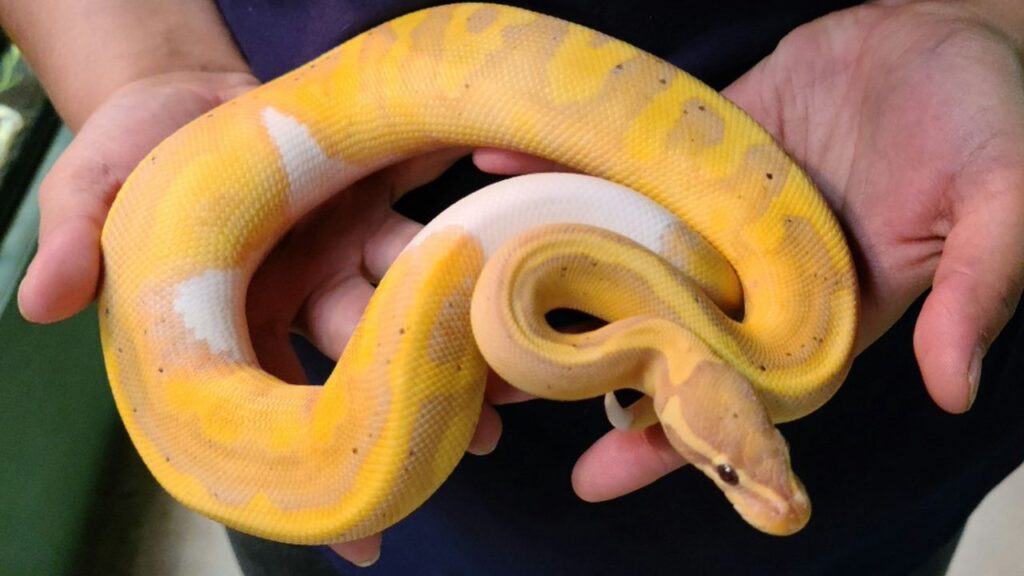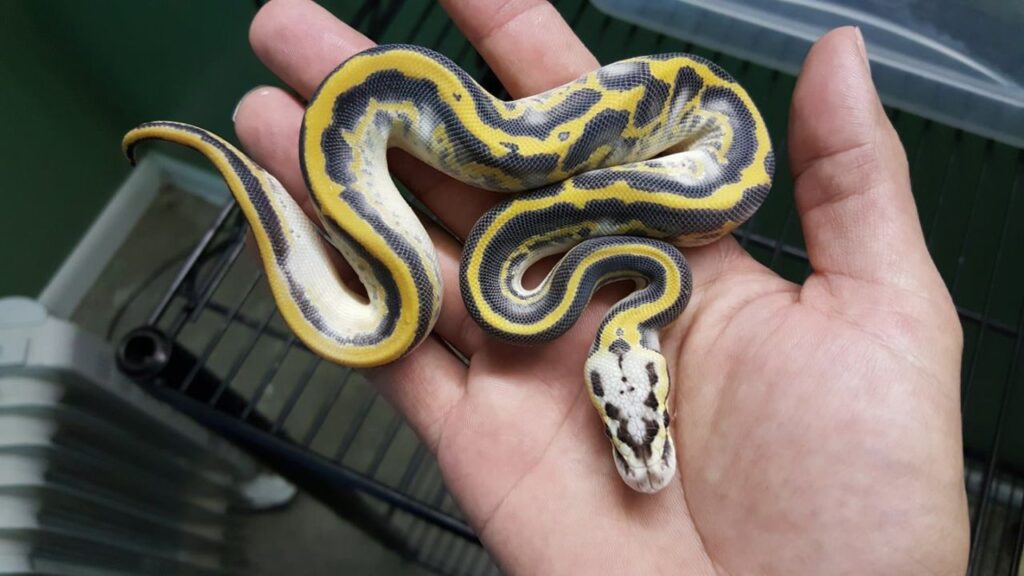What makes a ball python's home sweet home? The right substrate, of course!
When it comes to creating a comfortable and safe environment for your ball python, the substrate you choose plays a significant role.
The top 5 best substrates for ball pythons are coconut husk, cypress mulch, aspen shavings, reptile carpet, and bioactive substrate mixes.
Each of these options offers unique benefits that can enhance your ball python's enclosure. Coconut husk excels at moisture retention and is eco-friendly. Cypress mulch boasts natural antimicrobial properties and maintains humidity well. Aspen shavings are perfect for burrowing and absorb moisture effectively. Reptile carpet is low-maintenance and reusable, although it doesn't retain humidity. Bioactive substrate mixes create a self-sustaining habitat, but require more setup and maintenance.
Ultimately, the best substrate for your ball python will depend on factors like humidity control, ease of cleaning, and your snake's specific needs. By choosing the right substrate, you can create a comfortable and thriving environment for your pet.
Coconut Husk Substrate
Coconut husk substrate offers a natural, eco-friendly bedding option for your ball python's enclosure. It's made from the outer shell of coconuts, providing a sustainable and biodegradable choice for reptile owners who want to create a more natural habitat for their pets.
You'll find that coconut husk substrate has excellent moisture-retention properties, which can help maintain proper humidity levels in your ball python's enclosure. This is particularly beneficial for shedding, as the right humidity can ensure a smooth and complete shed. The substrate's ability to hold moisture also means you won't need to mist the enclosure as frequently.
When using coconut husk substrate, you'll notice it's lightweight and easy to clean. It doesn't compact easily, allowing your ball python to burrow and move through it comfortably. This substrate is also resistant to mold and bacteria growth, which helps keep your pet's environment clean and healthy.
To use coconut husk substrate effectively, you'll need to prepare it before adding it to the enclosure. Most brands require you to soak the substrate in water and then squeeze out the excess moisture. This process helps activate the substrate's moisture-retention properties.
While coconut husk substrate offers many benefits, it's important to monitor the humidity levels in your ball python's enclosure regularly. Excessive moisture can lead to respiratory issues, so ensure proper ventilation and adjust as needed. With proper care and maintenance, coconut husk substrate can provide a comfortable and natural environment for your ball python to thrive.
Cypress Mulch
When it comes to natural substrates for ball pythons, cypress mulch stands out as a popular and effective choice. This substrate is made from the bark of cypress trees and offers several benefits for your snake's enclosure.
Cypress mulch is known for its excellent moisture-retention properties, which can help maintain proper humidity levels in your ball python's habitat. This is particularly important for shedding and overall health. The mulch also has natural antimicrobial properties, which can help prevent the growth of harmful bacteria and fungi.
You'll appreciate how easy it is to spot clean cypress mulch. It's also relatively affordable and readily available in most pet stores. When using cypress mulch, make sure to choose a product that's specifically labeled for reptile use to confirm it's free from harmful chemicals or additives.
One potential drawback of cypress mulch is that it can be slightly dusty when first introduced to the enclosure. To minimize this, you can lightly mist the substrate before adding it to your snake's habitat. It's also important to note that some ball pythons may accidentally ingest small pieces of mulch while feeding, so always supervise feeding times and consider using a separate feeding container.
To use cypress mulch effectively, spread a layer about 2-3 inches deep across the bottom of the enclosure. Replace the substrate entirely every 4-6 weeks, or sooner if it becomes soiled or develops an unpleasant odor. By using cypress mulch, you're providing your ball python with a comfortable and natural substrate that mimics their native environment.
Aspen Shavings
Another popular substrate option for ball pythons is aspen shavings, which offer a different set of benefits compared to cypress mulch. Aspen shavings are lightweight, affordable, and excellent for burrowing, making them an attractive choice for many snake owners.
One of the main advantages of aspen shavings is their ability to absorb moisture effectively. This helps maintain a clean and dry environment for your ball python, reducing the risk of scale rot and other moisture-related health issues. You'll find that aspen shavings are easy to spot clean, allowing you to remove waste and soiled areas quickly.
Aspen shavings are also dust-free when properly processed, which is beneficial for your snake's respiratory health. They're naturally light in color, making it easier for you to monitor your pet's droppings and overall enclosure cleanliness.
However, bear in mind that aspen shavings don't retain humidity well. If you live in a dry climate or need to maintain higher humidity levels for your ball python, you may need to mist the enclosure more frequently or use a humidity box.
When choosing aspen shavings, opt for those specifically marketed for reptiles to verify they're free from harmful oils or additives. Avoid cedar or pine shavings, as these can be toxic to snakes.
To use aspen shavings effectively, create a layer about 2-3 inches deep in your ball python's enclosure. This depth allows for proper burrowing behavior while still being manageable for cleaning and maintenance.
Reptile Carpet
Reptile carpet offers a low-maintenance, reusable substrate option for ball python enclosures. It's designed to mimic natural surfaces while providing a clean and hygienic environment for your snake. You'll find that reptile carpet is easy to clean and doesn't create dust, making it a popular choice among snake owners.
When using reptile carpet, you'll need to take into account a few key factors:
| Aspect | Pros | Cons |
|---|---|---|
| Cleanliness | Easy to clean | Can harbor bacteria if not cleaned regularly |
| Humidity | Doesn't retain moisture | May require additional humidity measures |
| Safety | No risk of ingestion | Claws can get caught in fibers |
| Cost | Reusable and long-lasting | Initial cost higher than some substrates |
| Appearance | Natural look | Limited color options |
To use reptile carpet effectively, cut it to fit your enclosure precisely. This prevents your ball python from burrowing underneath. You'll need to clean the carpet regularly by removing it, washing it with a mild detergent, and thoroughly drying it before replacing it in the enclosure.
While reptile carpet doesn't provide burrowing opportunities, it does offer a stable surface for your snake to move around on. It's particularly useful for monitoring your snake's health, as droppings are easily visible on the surface.
Remember to have at least two pieces of carpet for each enclosure. This allows you to replace a soiled piece with a clean one while washing the other. By rotating between two carpets, you'll guarantee your ball python always has a clean surface to live on.
Bioactive Substrate Mixes
In recent years, bioactive substrate mixes have gained popularity among ball python enthusiasts for their ability to create a more naturalistic and self-sustaining habitat. These mixes typically consist of organic materials like soil, coconut fiber, sphagnum moss, and leaf litter. They're designed to support beneficial microorganisms and small invertebrates that help break down waste and maintain a healthy ecosystem within the enclosure.
When you're considering a bioactive setup for your ball python, you'll need to verify proper drainage and moisture retention. Start with a layer of clay balls or gravel at the bottom of the enclosure, followed by a substrate barrier to prevent mixing. Then, add your bioactive mix on top. You can customize the mix based on your snake's specific needs and the humidity requirements of your region.
One of the main benefits of bioactive substrates is their ability to process waste naturally. This can reduce the frequency of full substrate changes, saving you time and effort in the long run. However, bear in mind that bioactive setups require more initial setup time and ongoing maintenance to maintain the ecosystem's balance.
While bioactive substrates can provide a rich, stimulating environment for your ball python, they're not suitable for all situations. If you're new to snake keeping or prefer a more controlled environment, you might want to start with simpler substrate options. Always monitor your snake's health and behavior when introducing any new substrate to confirm it's adapting well to its environment.
Conclusion
You've now got a solid foundation for choosing the best substrate for your ball python.
Remember, each option has its pros and cons, so weigh them carefully.
Your snake's comfort and health are paramount, so don't cut corners.
Regularly clean and replace the substrate to maintain a hygienic environment.
With the right choice, you'll create a cozy home that'll have your ball python feeling snug as a bug in a rug.
Always prioritize safety and natural behaviors when setting up your pet's habitat.


